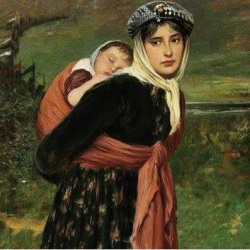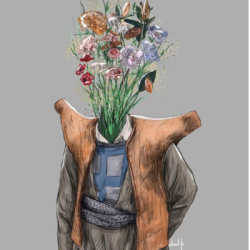Exploring Artistic Horizons: TPH's Inaugural Digital Art Session
Colors by Kurdish Lens - Endless Journey
By: Eman maged khaledEndless Journey
Living in nature rather than a closed area occupies a significant portion of Kurdish journey. The colors that Kurds were accustomed to seeing while growing up surrounded by nature have painted the Kurdish vibrant culture. Geography and culture are the main inspiration for art throughout different eras, Kurdistan's classical and modern traditions serve as the primary evidence of that. If we traveled back in time to glance at Kurdish art, we would be amazed by many artists and writers who tried to create an art piece to reflect Kurdish experience and nature while trying to prove our national identity and heritage. You will see yourself amazed by Baba Taher’s writings from the fifth Al Hijra century in a magical approach you will find yourself between the theater audience watching Mam and Zin a romantic historical story translated to many languages by Khani in1964, then Khani writings that has been incorporated to educational books for many generations for its linguistic andreligious importance (Nûbhara Bçokan;The Children’s New Spring) which contains 216 verses divided into 13 chapters including a short prose introduction. Kurdish language is categorized as an Indo-European language, and has long and deep historical roots.It is one of the most significant ancient oriental languages in high human literature.


Elements of Kurdish Arts
Kurdish art has evolved over the centuries and has been shaped by the artistic traditions of various civilizations, including ancient Mesopotamia ,and Islamic culture. Kurdish art elements reflect a rich history and diverse cultural influences, blending traditional and modern techniques across various forms of painting,symbolism, sculpture, textile, music ,calligraphy ,wool crafts, and woodwork.These art pieces are combined in creative ways to reflect the incredible cultural heritage of Kurdistan. Literature also plays an important role. It is clear that Kurdish literature is taken from its traditions ,history and heritage, including: poetry, prose, short stories,novels ,memoirs, essays, drama : plays , skits , and theatricals, and in addition to new exceptional artwork includes the following unique genres :
● Folklore : includes many different forms such as myths, legends, fables, and fairy tales. It reflects cultural traditions , often including elements of nature , romance, and adventure.
● Hayranok: Special Kurdish literature writings
● Nokta: jokes
● Pend: adage
● Mamk: mystery (a short question that has one word answer,in the past Kurdish people did it as a fun activity)
The content of Kurdish folklore (classics) has a big impact on its writings which were pioneered by Abdulrahim Hakari , Jaladat Badirxan ,Piramird , Goran,Talaat Saman …etc. Classical poetry is a major and influential factor in the development of Kurdish political identity and an essential element for Kurdish self-knowledge. Kurdish literature is divided into popular and written literature . Some consider Mulla Ahmad Jaziri (975 AD - 1055 AD) the first behind codification of Kurdish culture. Before that, Kurdish folk literature was oral, transmitted from generation to generation through narrators and singers who had the highest credit for preserving it. Storyteller - çîrukbèj and singer -Denkbèj are the pioneers of oral literature ; They reflect the nation’s beautiful spirit ,culture and history.The Kurdish storyteller (Sabri Rasool) says: the Kurdish oral heritage; is very rich, where you find in every generation an epic ,in every cave and valley a story, and with the flow of sweet springs there is a story and a legend told by stones, rivers and orchards…the Kurdish folklore stock is inexhaustible, waiting for someone to transmit it to others through the art of the word, as every Kurdish woman is a singer ( la ilaha ila allah- dhikr in soft sound ) Wonderful for her newborn in the cradle, and turns into an accomplished novelist (zangè o bangè-sheep and wolf story )when she becomes a grandmother.

Culture Inspired by Nature
Many Kurds tried to get inspiration from Kurdistan’s nature for their writings and artistic works. This led to having new words within the Kurdish literature that resembled different meanings such as: spring red flowers ( kolîlkèn buharè), autumn yellow hair (pîrça zara payîzî) ...etc. This has contributed to the development of a unique cultural identity, which is reflected in the education of folk performance and literature.by bringing all world ink to paint a view of Kurdistan nature cannot be achieved because of Kurdistan’s special astonishing natural colors. Meditation on nature and observing its unique views serves as a powerful tool to blend it with concepts and reveal the existing harmony between human and nature. This enables writers and artists to express themselves in a breathtaking and expressive manner. Martyr blood ,peace ,sun-rays,and green leaf are components of each Kurdish character that allows Kurdish people to create a special color palette inspired by the nature of Kurdistan.

